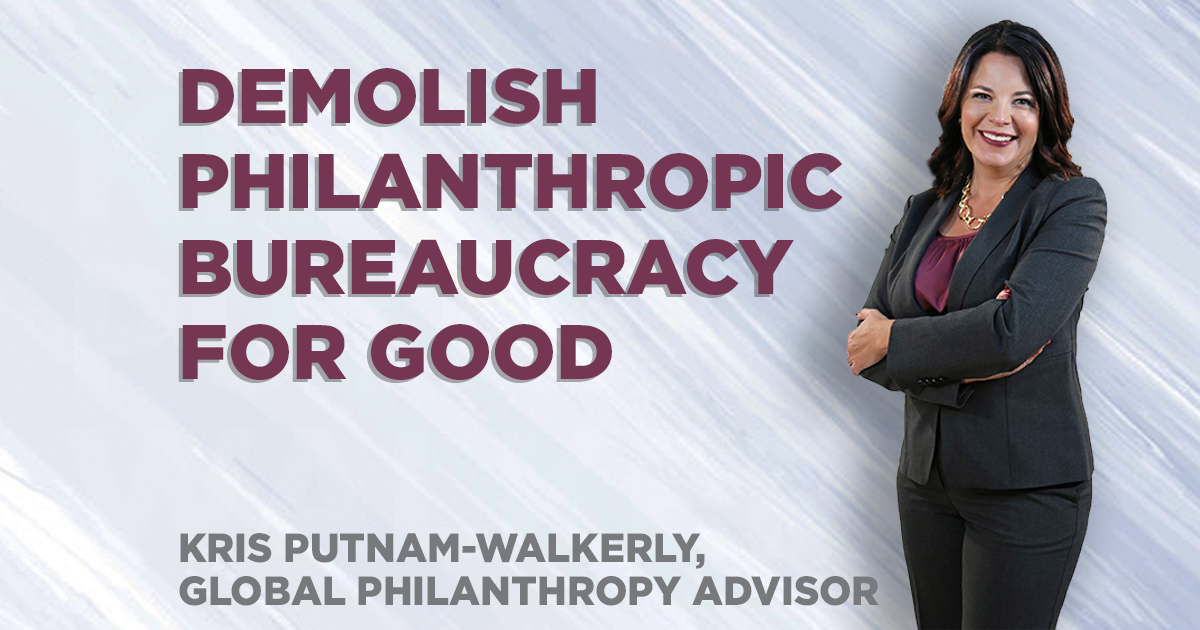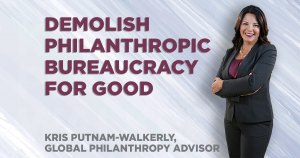Beat it back — or stop it before it even starts!
We often hear about streamlining philanthropy — mostly with regard to efforts at simplifying grant applications, approval processes and reporting requirements. Streamlining is great. But when it comes to philanthropic bureaucracy, sometimes what we really need is a bulldozer. Some bureaucratic processes are so ridiculous, they just need to be demolished.
Here’s a great example of philanthropic bureaucracy: 300-page board dockets. Imagine the joy on the board members’ faces when they receive those reams of paper in the mail to prepare for each board meeting. Imagine the hours and hours of foundation staff time that went into creating those reams of paper. Now, do you really think that anyone actually sits down and reads them?
You can recognize when it’s time for bureaucratic demolition. You might need to start tearing down your internal processes if you are:
- Releasing proposal guidelines that are 14 pages long, single-spaced (for grant proposals that cannot exceed eight pages).
- Giving four internal departments one week each to approve a Request for Proposal, but only giving applicants three weeks to prepare the proposal.
- Requiring a minimum of 90 days to approve a grant and send the check, regardless of the priority or emergency nature of the grant.
- Forcing a consultant or partner to send 14 follow-up emails and leave four voice messages before approving a contract that you requested and that is time sensitive.
- Delaying interaction with the outside world (partners, grantees, consultants, in-laws) because you’re consumed by a three-month budgeting process.
- Telling your vendors it will take two weeks to approve a payment (when really it takes two minutes).
 If these sound familiar to you, here are three ways to demolish bureaucracy before it destroys your impact:
If these sound familiar to you, here are three ways to demolish bureaucracy before it destroys your impact:
1. Conduct a bureaucracy-breaker audit.
Gather a team and take an honest look at the practices and processes that you currently use. Where do they begin to lose their effectiveness because they are overcome by complexity or complications? How are the requirements or requests of one department hindering another? What can you do to remove needless requirements, approvals or other steps to streamline and get to effective outcomes more quickly and simply?
2. Commit to the 50% principle.
First, identify a single form of bureaucracy that currently clogs up the works in your foundation — maybe it takes eight months to make a grant, or you require at least three consultants to submit proposals before you hire the one you already know you should use, or your board docket is two inches thick and no one will ever read it all. Then, brainstorm three things you can do to reduce it by half. What would it take to get grants out the door in four months instead of eight? How about if only one highly qualified consultant has to submit a proposal before you can hire her? And what unnecessary information and duplication can you remove to get your 200-page board docket down to 100 pages (or, better yet, 20 pages)?
3. Think like a 2-year-old.
As everyone knows, a 2-year-old’s go-to question is “Why?” Tap into your inner child and apply this question to everything you do in philanthropy. Are you about to make 14 copies of a grant proposal? Why? Are you about to send out an RFP for communications support when you already have a consultant you’re dying to work with? Why? Are you about to send your new grant guidelines to every internal department for review before you publish them? Why? Occasionally the answers to these questions deliver a satisfactory explanation, but what about the practices that have no good explanation? I encourage you to keep digging and keep asking why. You’re likely to uncover a false assumption upon which an entire bureaucracy has been constructed.
These three steps can help you find the bureaucracy in your organization, but they are all contingent actions. You can only destroy bureaucracy after it has spread and caused the internal delays, blockages and poor customer service that are its hallmarks. How can you take preventive action to stop bureaucracy before it starts?
Here are three solutions for keeping bureaucracy from sprouting in the first place.
1. Start out of the box.
One new CEO at a new health conversion foundation decided to create innovative new practices that would streamline the operations right from the start. She polled other funders to find out about non-bureaucratic policies and practices they used that might be relevant to her own operation and then used that information to build her own bureaucracy-free system from the ground up.
2. Picture yourself as a supermodel.
Ask yourself, “If this organization were to become a national model in effective [fill in the blank], what would that look like?” You can bet it would not look like a bloated government agency. Apply those attributes that are model-worthy and leave the rest behind.
3. Create a no-silo policy.
Bureaucracy loves a silo. Isolated areas of work allow for bureaucracy to grow easily, and in return that bureaucracy reinforces a siloed structure. On the flip side, silos abhor open interaction and communication — so that should be a backbone of your no-bureaucracy operation. Open and frequent communication breaks down walls, streamlines processes and even sparks new and innovative ideas.
I’ve been known to demolish some bureaucracy in my day, and I go after the task with gusto. But I’d prefer never to have to demolish anything in my own operation, or in those of the foundations and philanthropists I serve. If you’d like to work together to take a look at your own bureaucracy and demolish it for good, schedule a call with me!
This article was originally written for and published by Forbes.
© 2019 Kris Putnam-Walkerly. All rights reserved. Permission granted to excerpt or reprint with attribution.
About Kris Putnam-Walkerly
I’m a global philanthropy expert, advisor and award-winning author. I help ultra-high net worth donors, celebrities, foundations and Fortune 500 companies dramatically increase the clarity, speed, impact and joy of their giving. I’m the author of Confident Giving: Sage Advice for Funders, was named one of “America’s Top 25 Philanthropy Speakers”(along with U2’s Bono!), I write about philanthropy for Forbes.com, Alliance Magazine, De Dikke Blauwe and am frequently quoted in leading publications such as Bloomberg, NPR and WSJ.
Whether you are just getting started in philanthropy, want to refresh your giving strategy, or need to catapult yourself to your desired future, I can help. Let’s talk! Call me at +1-800-598-2102 x1, email me at kris@putnam-consulting.com or schedule a call.
__________________________________________________________________________
“Improving lives through philanthropy is a complex business, but Kris provided us with a clear, compelling story of our work with local partners and the real-world impact that’s had by the communities we serve. These are stories we’ll use and share with peers and grantee partners for years to come.”
Paul DiLorenzo, Senior Director, Casey Family Programs
__________________________________________________________________________
Want to learn more? Visit my website to learn how I help funders, access free resources, and read client testimonials.








